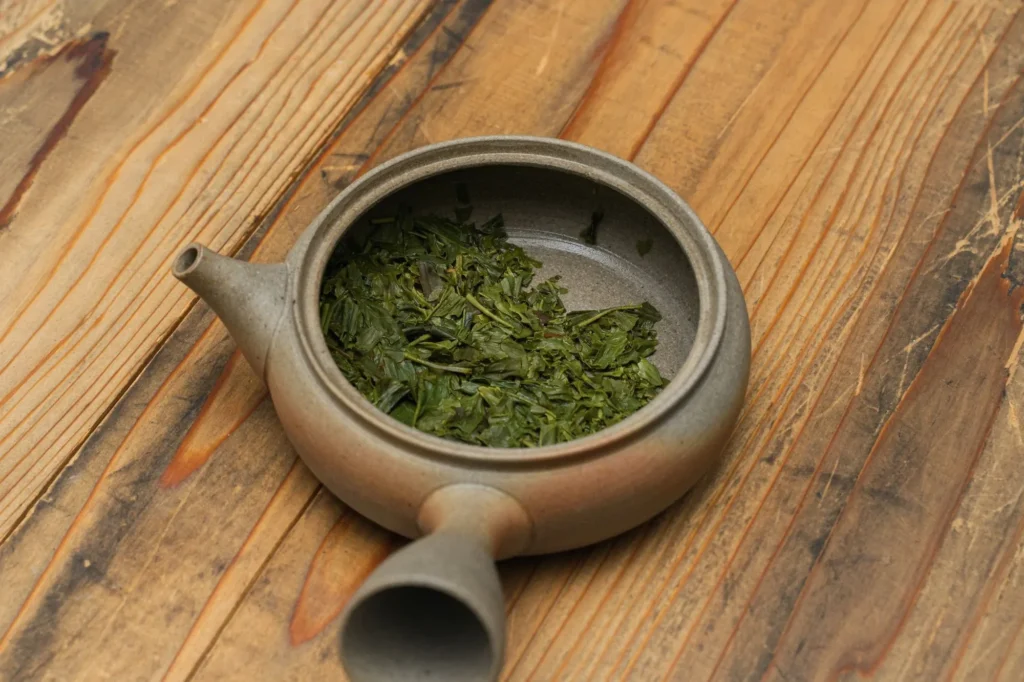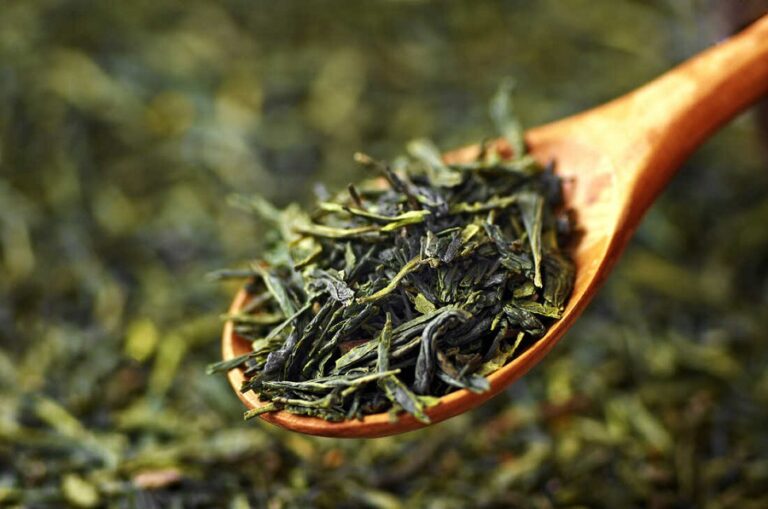Yes, you can eat tea leaves, but it’s not a common practice due to their somewhat bitter taste and tough texture. Tea leaves contain various compounds, including caffeine and tannins, which give them their characteristic flavor. While consuming small amounts of tea leaves won’t typically cause harm, eating large quantities may lead to an upset stomach or digestive discomfort due to their high concentration of these compounds.
However, some cuisines use tea leaves in cooking. For instance, in certain Chinese and Burmese dishes, tea leaves are used as an ingredient. In Japan, powdered green tea, known as matcha, is often incorporated into recipes for flavoring sweets, desserts, and even savory dishes.
How to Consume Tea Leaves?
Factors like the age of the leaves, their processing techniques, and the cultural context heavily influence the edibility and culinary uses of tea leaves.
Edibility of Tea Leaves
Tea leaves are generally considered edible, but the palatability and ease of consumption vary depending on several factors, including the type of tea, its processing methods, and its culinary uses.
Factors Influencing the Edibility

Types of Tea Leaves
Young, tender leaves with a subtle flavor profile; often more palatable for consumption after steeping. Fully oxidized leaves with a robust flavor; less commonly consumed directly due to their stronger taste.
Minimal processing, delicate flavor; suitable for consumption but less common due to their rarity and cost. Partially oxidized leaves; varied flavors, some types may be consumed after steeping.
Processing Methods
Higher oxidation levels (e.g., black tea) often results in stronger-tasting leaves less favored for direct consumption. Some teas undergo additional roasting or drying processes that may affect the texture and flavor, impacting their edibility.
Culinary Uses
In Chinese and Burmese cuisines, tea leaves are used in various dishes, sometimes as a flavoring agent or as a key ingredient (e.g., in salads or savory dishes).
Contemporary recipes incorporate tea leaves creatively, such as using matcha powder in desserts, smoothies, and savory dishes for its unique flavor and health benefits.
In some cultures, particularly in China, the practice of eating whole tea leaves after steeping is observed, particularly with young and tender leaves that are more palatable.
What are the Health Benefits and Risks of Tea Leaves?
It’s crucial to note that the health effects of consuming tea leaves can vary widely based on individual tolerance, the type of tea, and the quantity consumed.
Nutritional Content of Tea Leaves
Tea leaves contain polyphenols, including catechins and flavonoids, known for their antioxidant properties that help combat oxidative stress and reduce the risk of chronic diseases.
Tea leaves contain small amounts of vitamins (like vitamin C, vitamin K) and minerals (such as manganese, potassium) that contribute to overall health but vary depending on the type and processing of the tea.
Potential Benefits of Consuming Tea Leaves
The antioxidants in tea leaves may contribute to reducing inflammation, supporting heart health, and potentially lowering the risk of certain cancers.
Tea leaves contain caffeine, which can enhance cognitive function, alertness, and concentration, promoting mental clarity.
Risks and Side Effects
Caffeine Content
Tea leaves contain caffeine, albeit in lower amounts compared to coffee. Consumption in moderation can offer a mild stimulant effect without causing excessive jitters or restlessness.
Some individuals may be more sensitive to caffeine and might experience side effects like insomnia, nervousness, or an upset stomach with excessive consumption.
Tannins and Digestive Issues
Tea leaves contain tannins, natural compounds that may contribute to astringency and bitterness. In excess, tannins can sometimes lead to digestive discomfort or interfere with iron absorption.
Consuming large amounts of tea leaves, especially if they are whole leaves or not well-processed, might result in gastrointestinal discomfort, including stomach upset or irritation.
What are Traditional and Modern Culinary Uses of Tea Leaves?

Tea leaves, with their unique taste and aroma, offer versatility in culinary applications beyond the traditional brewing of tea.
Incorporation of Tea Leaves in Cooking
Traditional Cuisines
In Chinese cooking, tea leaves are utilized in various ways. For instance, in the province of Sichuan, tea-smoked dishes are popular, where meats like duck or chicken are smoked using tea leaves to impart a unique flavor. Additionally, tea-infused broths or sauces might be used in certain regional dishes.
Burmese tea leaf salad, known as “lahpet thoke,” is a signature dish made with fermented tea leaves mixed with various ingredients like crunchy nuts, seeds, tomatoes, and garlic oil. It’s a savory and slightly bitter dish, often enjoyed as a snack or accompaniment to a meal.
While not as common as in Chinese or Burmese cuisines, tea leaves are used in some Japanese recipes. For instance, matcha, a powdered green tea, is a staple ingredient in traditional Japanese tea ceremonies and is also used in making desserts like matcha-flavored mochi, cakes, or ice cream.
Dishes and Recipes Using Tea Leaves
Apart from Chinese cuisine, tea-smoking is also adopted in other cultures to flavor meats and fish, where tea leaves are used as a smoking agent to impart a distinctive aroma.
Tea leaves can be used to infuse sauces or marinades, adding depth of flavor to dishes like stir-fries, glazes for meats, or dressings for salads.
Modern culinary trends often incorporate tea leaves into desserts and baked goods. For instance, tea-infused custards, puddings, or cookies, where the tea leaves impart a subtle yet distinct flavor profile.
FAQ’s
Are tea tree leaves edible?
Tea tree leaves, from which tea tree oil is derived, are not typically considered edible for consumption.
Is tea tree bad if swallowed?
Swallowing tea tree oil can be harmful and toxic, leading to potential side effects such as stomach pain, nausea, or even poisoning if ingested in larger quantities.
Can you eat raw green tea leaves?
While technically possible, eating raw green tea leaves is uncommon due to their bitter taste and tough texture. They are often processed and brewed for tea.
What part of the tea plant is edible?
Generally, the young and tender leaves of the tea plant are considered edible and are used for making tea. Other parts are not commonly consumed.
Can I put tea tree in my mouth?
It’s not recommended to put tea tree oil in your mouth as it can cause irritation, burning sensations, or toxicity if ingested.
What happens if you accidentally eat essential oils?
Accidentally ingesting essential oils, including tea tree oil, can lead to adverse effects such as stomach upset, nausea, vomiting, or more severe reactions in some cases. It’s essential to seek medical advice if ingested accidentally.
Final Words
In conclusion, tea leaves are edible and can be consumed in various ways. They come in different types, like green, black, white, and oolong, each with its own flavors. People can eat tea leaves after steeping or use them in cooking, especially in Chinese, Burmese, and Japanese dishes. Tea leaves have antioxidants that can be good for health, but they also contain caffeine and tannins, so it’s essential to consume them in moderation.
Overall, tea leaves offer versatility in both culinary uses and potential health benefits, but it’s important to be mindful of individual preferences and potential side effects when enjoying them.

